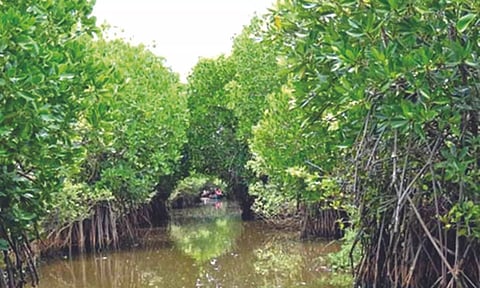

CHENNAI: In the last few years, the impact of cyclones and floods in the coastal districts of Tamil Nadu is increasing. While the climate change has increased the intensity of cyclones that hit the state, loss of coastal plantations and vegetation like mangroves, sand dunes and others exacerbate the negative impact since such vegetation act as bio-shield.
According to a baseline study conducted by the National Centre For Coastal Research (NCCR) with the support of Indian National Centre for Ocean Information Services (INCOIS), Tamil Nadu has lost around 12 per cent net loss of coastal vegetation between 2013 and 2023. In 2013, the state had a total plantation area of 11,131 sq km. The area decreased to 10,128 sq km in 2018 and 9,726 sq km in 2023. The coastal plantation occurs within 1 kilometer from the shoreline.
Mangroves decline in Thanjavur, Tiruvarur
While analysing the mangroves, which is the most ecologically significant coastal vegetation, the researchers found out that a decline of 34.92 per cent and 11.83 per cent of mangrove cover has been lost in Thanjavur and Tiruvarur districts. Large parts of these districts are covered with Muthupet region mangroves, which exhibit an overall decline in mangrove cover.
Mayiladuthurai gives some hope
“The Pichavaram reserve forest mangrove area is a well-established bio-shield surrounded by Uppanaru backwaters and Kollidam river, as no notable gain or loss is observed there. The remarkable 61.96 per cent gain in the Kattur mangroves of the Mayiladuthurai district makes it worth noting as a potential location for additional mangrove extension,” the study report said.
As per the 2021 Forest Survey of India report, Tamil Nadu has 4,500 hectares of mangrove forest cover. Including mangrove forests and patches of all sizes, the mangroves have been found to cover a total area of 6,473 hectares of Tamil Nadu’s coasts, in 2023. The state coasts have 2,437 hectares of sand dunes within 500 metres from the shoreline.
Mangrove forests in Chennai can’t act as bio-shield
Of the total mangroves, coastal plantations and sand dunes, 5,120 hectares of mangroves, 7,123 hectares of coastal plantations and 2,437 hectares of sand dunes have a potential to act as bio-shield from disasters. Chennai has 59 hectares of sand dunes and 24 hectares of coastal plantations that have the potential. Despite 85 hectares of mangroves, mangrove forests in Chennai do not have potential to be bio-shield.
1,309 ha have restoration potential
The National Centre for Coastal Research also has identified potential areas available for restoration and rehabilitation through remote sensing. As per the report, as much as 1,309 hectares of coasts have potential for mangrove restoration. More than 24,000 hectares and 1,013 hectares of coasts have a potential of coastal plantation and sand dune restoration.
“During the December 2004 Indian Ocean tsunami, the mixed species shelterbelt plantation, such as Casuarinas, Borassus and other thick coastal vegetation had a positive effect through friction/obstruction created by these rows of trees, reducing disaster impact,” the report cited.
Changing beaches
Analysis of the state beaches reveal that over the past four years, the coastal width of Rameswaram district has experienced significant changes. Chennai and Tiruvallur districts remain relatively stable, with changes of 2 hectares. Kancheepuram (5 hectares) and Kanniyakumari (22 hectares) districts have witnessed a reduction in beach width area. Around 41 per cent of the coast is falling in erosion category, 23 per cent is in accretion category and remaining 36 per cent in stable category.